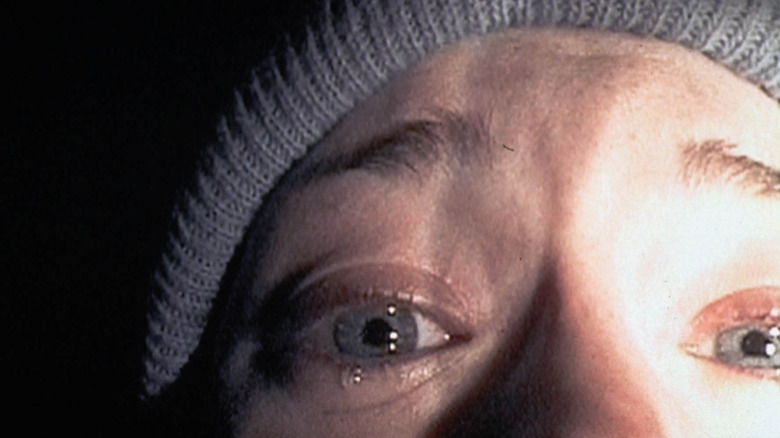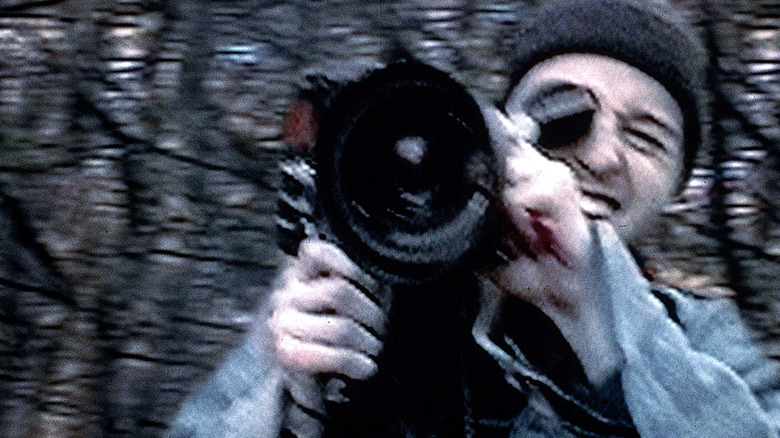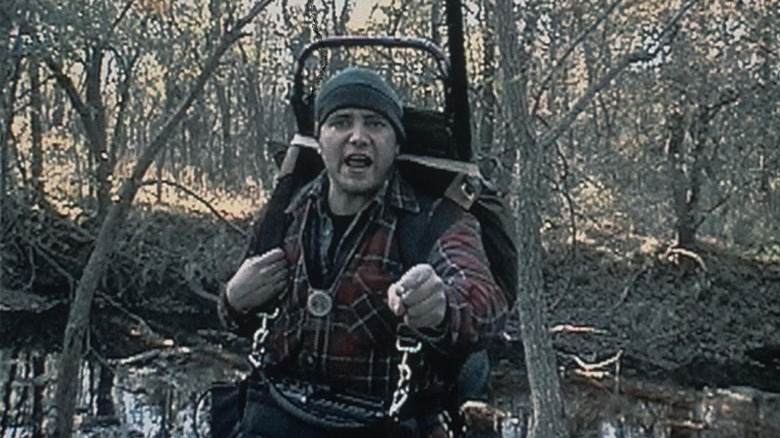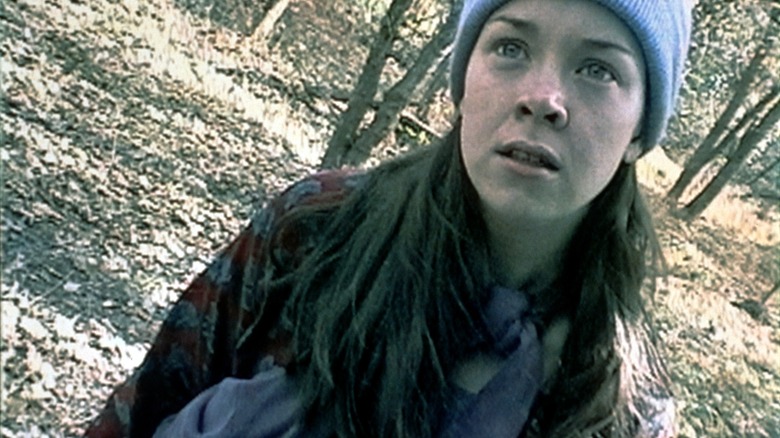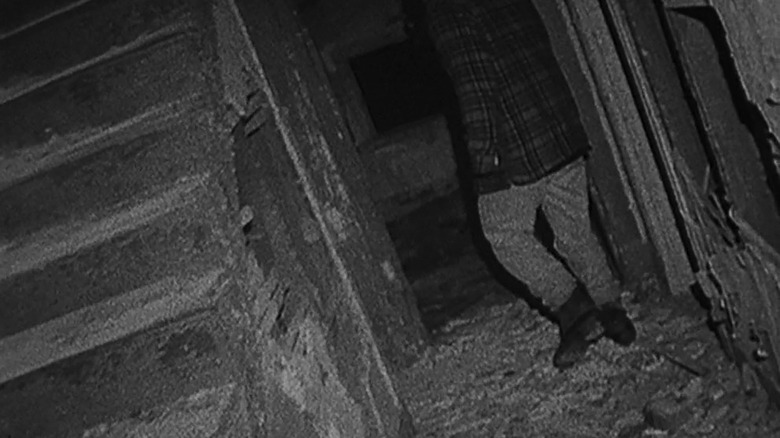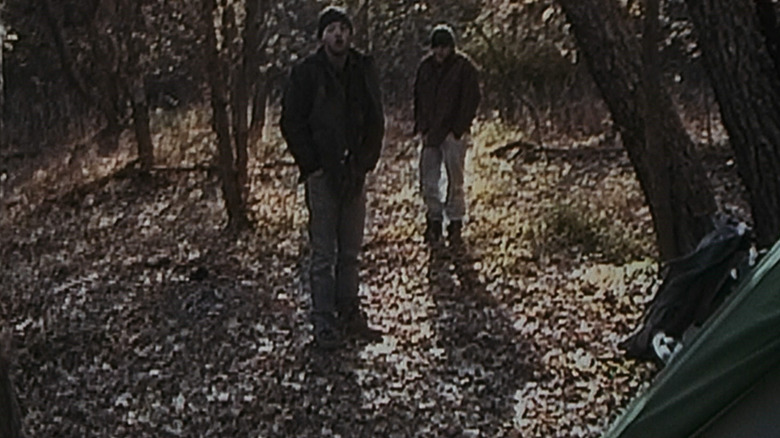Why The Blair Witch Project Was A Nightmare To Film
The story of "The Blair Witch Project" is the stuff of indie movie legend. Made in 1999 for a mere $60,000 and shot by the actors in the woods, the film went on to be an enormous box office sensation and zeitgeist-rattling horror touchstone, earning over $250 million worldwide.
Directed by Daniel Myrick and Eduardo Sánchez, "The Blair Witch Project" was shot in a documentary style, and purported to be the real footage of real people who actually got lost in the woods and who perhaps encountered the bizarre supernatural leavings of a real witch. They heard eerie noises at night, and a mysterious unseen figure hung effigies around their tents, and left them little bundles that contained ... well, that should remain hidden for those who haven't yet seen it.
A big reason for the film's success can be attributed to its marketing, most notably, the then-novel use of its website, blairwitch.com. On it, the filmmakers perpetuated rumors that "The Blair Witch Project" was real, that the subjects of the film had really died, and that the footage had indeed been found and edited together after the fact. There were also tie-in mockmentaries, meant to grow the myth of the Blair Witch, leading some visitors of the website to conclude that it was actually real. "The Blair Witch Project" was a prank of the highest order, and an amazing horror film to boot.
But making "The Blair Witch Project" was a nightmare. Actually filming in the woods, guerilla-style, turned out to be harrowing for the filmmakers.
The Auditions Were Unusual
In testimonials given to Vice Magazine, the directors shared their strange way of auditioning actors. When an actor entered the room, unusual questions would immediately begin, meant to test any potential cast members abilities to think on their feet and to improvise. Some actors were taken off-guard by this. Others rolled with it. Actress Heather Donahue said that the first question asked her at the audition was not about her experience as an actress, but "You have served half of your sentence for killing your baby. Why should we let you out?" Donohue said "I don't think I should." She got the part.
Another requirement of the part was camera operation, as the actors would also serve as the film's cinematographers. Actor Joshua Leonard chalks his winning of the role up to his camera experience.
Camping in the Woods with Actual Specters
In order to maintain authenticity, and to keep the budget down, "The Blair Witch Project" was actually filmed in the woods on Maryland with the actors filming each other and improvising a lot of their dialogue. The directors would give them instructions as to what they wanted to happen to the characters during the day, and then leave them all alone, shadowing them all the while. The cast also slept overnight in the very tents they were carrying on camera. It was as close to an actual documentary as one could get.
At night, the directors would sneak over to the actors' tents and shake them without warning. They would play spooky sounds on boomboxes out in the woods. And it was the directors who would leave the piles of rocks and stick figures for the cast to discover. All the reactions are pretty authentic. Director Myrick likened the filming to staging an improvised play that was running 24 hours a day for five days.
Heather Donahue was warned by her family not to make a movie in the woods with a bunch of guys she didn't know; a reasonable fear. Josh Leonard, high on the experimental works of Maya Deren and Kenneth Anger, was just eager to push the edge of experimental filmmaking himself. He also admits that he was also high on marijuana. The actors understood that they would be safe 100% of the time ... but that they would not be comfortable.
How Real Was It?
Luckily for everyone, the actors were game, and willing to be uncomfortable, scared, and unglamorous. Donahue was criticized at the time for being so willing to scream, to be scared, to ugly-cry on camera. She was awarded a Razzie that year for her efforts. As usual, however, the Razzies were merely being mean-spirited, piling upon a backlash to the film's extreme success.
Donahue, Lucas, and Michael C. Williams, the three actors, were so convincing in their performances that rumors about the Blair Witch's reality flared up time and time again. When the actors began making press tours, revealing that they had indeed survived the events of the film, and that "The Blair Witch Project" was indeed fiction, new rumors arose that the directors had actually convinced the cast that The Blair Witch was indeed real. As such, many audiences may have known that the footage was faked, but some believed that the actors believed it was real. The performances were so authentic and the filmmaking style so raw, surely they felt they were actually in danger. One might become intensely concerned about the ethics of that.
As it turns out, portions of the film were actually shot in a more traditional way, with the filmmakers coming in to do work with the actors in person, arrange proper lighting setups, and do multiple takes. The final sequence of the movie, set in a mysterious, rotting house in the woods — some would say the scariest part — was filmed this way. Donahue carried the camera and screamed a lot, but it required more cinematic choreography than the improvised portions in the woods, allowing the directors to come in and oversee.
Was it Safe?
That's not to say there wasn't some deliberate discomfort. Myrick admits that the directors deliberately scaled back the cast's food supply over the course of the shoot, ensuring that the actors would be grumpy. Not malnourished, mind you, but cantankerous.
But everyone played safe, even to the point of having a safe word. If the actors ever felt that they were in danger, or were uncomfortable to the point of wanting to stop filming, the cast merely needed to say "Bulldozer." The actors also had to play some incredibly intense scenes of fear and anger, and if the scene got too intense, or the yelling perhaps began to feel a little bit too real, they could use the safe word "taco."
Donahue, however, recalls the one time the safe word was used didn't work. It was raining on the day in question, and the actors were cold and miserable. They set up their own tents and found they were filling with water. Donahue felt that actors shouldn't have to deal with such conditions, and radioed the safe word to the directors ... who were having dinner in a restaurant. The cast had to walk away from the "set" and find a local cabin to make a phone call back to the directors (Donahue was assigned the task, as the other actors felt she was the least intimidating to a stranger). The stranger in question gave them hot chocolate and they made their way to a hotel.
The Nightmare After Release
After the harrowing shoot and miserable conditions, and after all the intense days of improv came to an end, the above-mentioned marketing began, and it aided "The Blair Witch Project" in becoming one of the most successful films of all time. But the nightmare wasn't over, at least not for the actors. Since part of the marketing for "The Blair Witch Project" was maintaining the myth that it was actual found footage, the rumors that the actors had indeed died was perpetuated (Artisan Entertainment — who handled the marketing and took credit for the website — even altered the IMDb entries of the actors to say they had died). Hollywood acting agencies didn't reach out to the cast because, well, everyone thought they were dead. The actors' parents started getting flowers and cards offering condolences. Donahue was frustrated by how effectively she "died," and, after a decade of appearances in a few raunchy comedies and low-budget horror movies, retired from acting to become a marijuana farmer. She even wrote a book about her experiences called "Growgirl: The Blossoming of an Unlikely Outlaw."
There was also a pretty severe backlash to "The Blair Witch Project" that the denizens of 1999 recall well. Critics praised the film, but many audiences left feeling cold — when one is promised the scariest film in a generation, and they get an experimental improv exercise with a lot of screaming and shaky-cam, one may walk away upset that there wasn't more gore, more monsters, more ... something. The extreme success of "The Blair Witch Project" was ultimately an albatross around its neck, leading it to Razzie nominations, and a several-years-long round on internet forums calling it unscary and overrated. Donahue likened the film's success to a tumor or a regrettable facial tattoo.
The legacy of "The Blair Witch Project," however, is ultimately positive. It was a film that showed how success could be mined from a minuscule budget and some clever marketing, and the aesthetic of the film remains novel and bracing. It's often seen as the forerunner to a slew of found-footage horror movies that dominated the movie landscape for the better part of a decade — ushered in by "Paranormal Activity," a film that borrows heavily from "Project," and saw a similar success.
"Blair Witch" also ensured that future found-footage films would be union jobs. Safe words are, one might assume, no longer needed.
